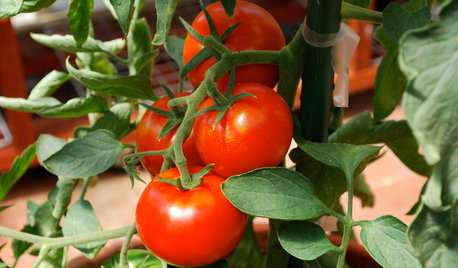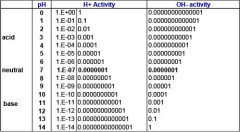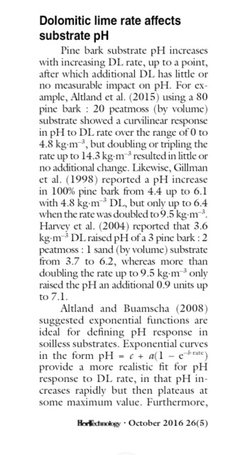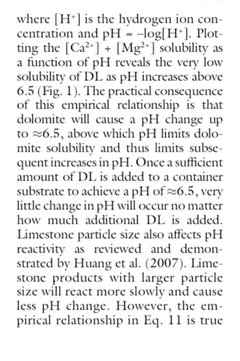How Much Lime to Adjust Container Soil pH to Any Arbitrary Target
westes Zone 9b California SF Bay
2 years ago
Featured Answer
Sort by:Oldest
Comments (60)
westes Zone 9b California SF Bay
2 years agoRelated Discussions
pH correction in 'potting soil'
Comments (2)What kind of plants are you planning to grow in this mix? The only types I know of that might appreciate a sand/peat mix are carnivorous or other bog type plants. And they frequently prefer acidic conditions....See MoreMixing soils and ammedments to achieve target pH
Comments (5)Howdy Neighbor! The short answer is no for a mixture for a specific pH. The longer answer is that the more organic matter the more lower and more stable the pH is. Organic amendments will help prevent the pH of the soil from fluctuating, just as it helps keep soil moisture and temperatures stable. If you want to grow blueberries, don't get lime anywhere near where you want to plant blueberries. Don't even get the bag of lime near the blueberries. Blueberries need soil that with lots of organic matter and a low pH. They have very shallow root systems, so you don't have to amend the soil very deeply to give them the organic matter they need. You don't need to add any additional top soil, just lots of organic matter to your existing soil. Where you are going to plant the blueberries, remove a few inches of existing sod and soil if you can. If not, you can add a few inches of peat moss and pine mulch and/or compost to the top of the existing soil, and plant the blueberries on a slightly raised berm. Blueberries need consistent moisture, but not wet soggy soil, so a slightly raised planting area can work well with heavy soils. If you have any experience growing azaleas, other Rhododendrons, or mountain laurel, then blueberries are in the same plant family, Ericace. Blueberries have much the same soil and fertilizer requirements, except more so. One of the cheap soil pH meters that costs less than $10 will help you get the soil pH right, which is essential to growing blueberries. As chemicals in the soil react, its pH will change over time. For example, watering with hard tap water that contains calcium will raise the pH. Acidifying soil amendments and sulfur will take some time to lower the soil's pH. If you are planning to plant only a few blueberry bushes, a gallon jug of cider vinegar is a cheap, easy, and fast way to lower the soil pH. First, mix a cup of vinegar with a gallon of water. Then as you water the blueberry plants, add a cup of the dilute vinegar mixture, wash the vinegar into the soil well, and then wait a few days to retest the soil's pH before adding any more. A pH of 4.5 to 5.5 is okay, and 5 if better. Once you get it right, test again every few months until you have a feel for how stable the pH is. The soil here is East Tennessee is slightly acid that will need to be lowered a bit usually, but will be fairly stable once you add plenty of organic matter. If your blueberries are already planted and you are adding amendments, be careful when trying to incorporate the amendments, because the roots are very shallow. The easiest way is to put the organic amendments on top as a mulch and let nature incorporate it, and it is fairly effective as well. For adding organic matter to your soil, you can pile up any of the following and allow them to rot to prepare an area for planting blueberries: grass clippings, tree leaves, hay, straw, peat moss, wood chips. Small amounts of manure are great, but don't use too much. I've got three blueberries growing in containers I planted this spring. You must plant more than one variety for pollination. I planted Chippewa because it is a compact medium size bush that is a good size for containers that produces in mid-season. I planted a Brigitta because it is a very late season producer. I planted a Chandler, because it is supposed to have larger berries that any other kind. They all three have survived our hot summer in 18 gallon containers without any problems this year. They were about 2 inches tall when I planted them in late March. The Chandler and Chippewa have grown several branches about 18 inches long this summer. My Brigitta has grown almost twice as fast to nearly 3 feet, even though they've all had the same soil, water, sun, fertilizer, etc. The link below from the UT Extension Office has some general info on growing blueberries here in East Tenn, including some recommended varieties. Good Luck, Greg - West Knoxville Here is a link that might be useful: UT Extension Office - Blueberries in Home Gardens...See MoreHow quickly can I lower pH of soil in order to plant acidic plants?
Comments (13)See if you can find Soil & Water dudes to talk to instead of Cooperative Extension. How old is the construction? If it is more than 5 years old, then alkaline leaching has already occurred, and you've got what you've got. My personal experience, living in a lime pocket among an assortment of lime pockets, is that most gardeners have been quite thoroughly brainwashed into thinking anything in the east has to be acidic. It just isn't so. So when confronted with an alternate reality, they come up with excuses. Concrete leaching is a classic. Older concrete doesn't leach, and the leaching doesn't travel much. I don't know how many times I've been told that I should stop liming, and then I will have 'normal' acidic soil. If you want to know how the neighbor grows camellias, go over and ask. And no, my soil doesn't fizz either, and my pH, and calcium numbers are very similar to yours....See MoreCan I garden while lime is actively raising the pH of my soil?
Comments (12)gardengal, I've heard the same. Asked our ag extension about why the soils around here need repeated liming from time to time out here and he said in some regions the soil is just naturally lower in pH and tends to revert to its native condition. Fortunately most of my land will be used for pasture and bermuda is fine with a fairly low pH. My CEC is quite high actually, which, with regard to liming, means I can lime less often and in larger amounts than if I had a sandier soil with pH problems. But feel free to say more about buffering, as I'm still learning what this means for the liming process. Feel free to say more about anything. :) I was quite low in calcium, not surprisingly, a little low in potassium and phosphorus. To answer your direct question I've gotten two different reports on pH. First report, through Logan Labs, was 5.3. It was of samples taken over a wide variety of the pasture (40 acres). The other was about 6.0, from OSU, but it was taken solely from the previous garden area, which had been heavily amended. I'm going to establish a new garden area. Two actually, and rotate them in and out of business. I'll be growing the usual things for OK and Texas (I'm near the border) when you get decent rainfall: southern peas, okra, squash, tomatoes, beans, but also potatoes, onions, and various leafy vegetables such as chard, kale and spinach....See Morewestes Zone 9b California SF Bay
2 years agowestes Zone 9b California SF Bay
2 years agolast modified: 2 years agowestes Zone 9b California SF Bay
2 years agolast modified: 2 years agowestes Zone 9b California SF Bay
2 years agolast modified: 2 years agowestes Zone 9b California SF Bay
2 years agolast modified: 2 years agowestes Zone 9b California SF Bay
2 years agolast modified: 2 years agowestes Zone 9b California SF Bay
2 years agolast modified: 2 years agowestes Zone 9b California SF Bay
2 years agowestes Zone 9b California SF Bay
2 years agolast modified: 2 years agowestes Zone 9b California SF Bay
2 years agowestes Zone 9b California SF Bay
2 years agowestes Zone 9b California SF Bay
2 years agolast modified: 2 years agowestes Zone 9b California SF Bay
2 years agolast modified: 2 years agowestes Zone 9b California SF Bay
2 years agolast modified: 2 years agogreenman28 NorCal 7b/8a
2 years agolast modified: 2 years agowestes Zone 9b California SF Bay thanked greenman28 NorCal 7b/8awestes Zone 9b California SF Bay
2 years agolast modified: 2 years agowestes Zone 9b California SF Bay
2 years agowestes Zone 9b California SF Bay
2 years agoJonah Henry
2 years agolast modified: 2 years agowestes Zone 9b California SF Bay thanked Jonah Henrywestes Zone 9b California SF Bay
2 years agowestes Zone 9b California SF Bay
2 years ago
Related Stories

EDIBLE GARDENSNatural Ways to Get Rid of Weeds in Your Garden
Use these techniques to help prevent the spread of weeds and to learn about your soil
Full Story
GARDENING GUIDESGarden Myths to Debunk as You Dig This Fall and Rest Over Winter
Termites hate wood mulch, don’t amend soil for trees, avoid gravel in planters — and more nuggets of garden wisdom
Full Story
GARDENING 101How to Grow Tomatoes in Pots
Don’t have much space for a garden? All you need is a sunny spot and a large container to grow this favorite summer crop
Full Story
MATERIALSInsulation Basics: What to Know About Spray Foam
Learn what exactly spray foam is, the pros and cons of using it and why you shouldn’t mess around with installation
Full Story
HOUSEKEEPINGTackle Big Messes Better With a Sparkling-Clean Dishwasher
You might think it’s self-cleaning, but your dishwasher needs regular upkeep to keep it working hard for you
Full Story
HOUSEKEEPINGHow to Clean Your Washing Machine
Cleaning your washer once a month will ensure that it stays spick-and-span along with your clothes
Full Story
LANDSCAPE DESIGNNatural Swimming Pools: More Beauty, No Chemicals
Keep your skin and the environment healthy with a pool that cleans itself, naturally
Full Story
HOUSEKEEPINGHow to Clean Marble Countertops and Tile
Acidic solutions can damage your marble surfaces. Here’s how to keep marble looking clean and amazing
Full Story
WORKING WITH PROSWhat Do Landscape Architects Do?
There are many misconceptions about what landscape architects do. Learn what they bring to a project
Full Story
UNIVERSAL DESIGNWhat to Look for in a House if You Plan to Age in Place
Look for details like these when designing or shopping for your forever home
Full StorySponsored
Central Ohio's Trusted Home Remodeler Specializing in Kitchens & Baths









kevin9408